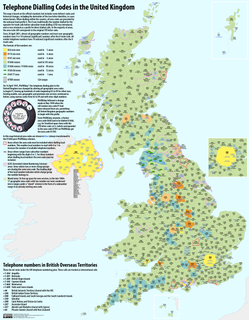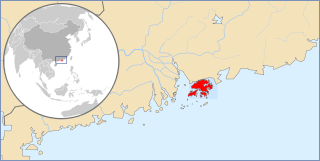An automatic number announcement circuit (ANAC) is a component of a central office of a telephone company that provides a service to installation and service technicians to determine the telephone number of a line. The facility has a telephone number that may be called to listen to an automatic announcement that includes the caller's telephone number.
Interexchange carrier (IXC) is a U.S. legal and regulatory term for a telecommunication company, commonly called a long-distance telephone company. It is defined as any carrier that provides services across multiple local access and transport areas (interLATA). Calls made on telephone circuits within the local geographic area covered by one local network are handled only by that intraLATA carrier, commonly called a local telephone exchange carrier. Local calls are usually defined by connections made without additional charge whether the connected call is in the same LATA or connects to another LATA with no charge. IntraLATA usually refers to rated or toll calls between LATA within state boundaries, as opposed to interstate, or calls between LATAs in different states.

The North American Numbering Plan (NANP) is a telephone numbering plan that encompasses twenty-five distinct regions in twenty countries primarily in North America, including the Caribbean. Some North American countries, most notably Mexico, do not participate in the NANP.
Automatic number identification (ANI) is a feature of a telecommunications network for automatically determining the origination telephone number on toll calls for billing purposes. Automatic number identification was originally created by AT&T Corporation for internal long distance charging purposes, eliminating the need for telephone operators to manually request the number of the calling party for a toll call.
Premium-rate telephone numbers are telephone numbers for telephone calls during which certain services are provided, and for which prices higher than normal are charged. Unlike a normal call, part of the call charge is paid to the service provider, thus enabling businesses to be funded via the calls. While the billing is different, calls are usually routed the same way they are for a toll-free telephone number, being anywhere despite the area code used. These telephone numbers are usually allocated from a national telephone numbering plan in such a way that they are easily distinguished from other numbers. Telephone companies typically offer blocking services to allow telephone customers to prevent access to these number ranges from their telephones. In some jurisdictions, telephone companies are required by law to offer such blocking.
A toll-free telephone number or freephone number is a telephone number that is billed for all arriving calls instead of incurring charges to the originating telephone subscriber. For the calling party, a call to a toll-free number from a landline is free of charge.
A telephone numbering plan is a type of numbering scheme used in telecommunication to assign telephone numbers to subscriber telephones or other telephony endpoints. Telephone numbers are the addresses of participants in a telephone network, reachable by a system of destination code routing. Telephone numbering plans are defined in each of administrative regions of the public switched telephone network (PSTN) and they are also present in private telephone networks. For public number systems, geographic location plays a role in the sequence of numbers assigned to each telephone subscriber.

Telephone numbers in the United Kingdom are administered by the UK government's Office of Communications (Ofcom). For this purpose Ofcom established a telephone numbering plan, known as the National Telephone Numbering Plan, which is the system for assigning telephone numbers to subscriber stations.

The Australian telephone numbering plan describes the allocation of phone numbers in Australia. It has changed many times, the most recent major reorganisation by the Australian Communications and Media Authority taking place between 1994 and 1998.
In telecommunications, a long-distance call (U.S.) or trunk call is a telephone call made to a location outside a defined local calling area. Long-distance calls are typically charged a higher billing rate than local calls. The term is not necessarily synonymous with placing calls to another telephone area code.
In Argentina, area codes are two, three, or four digits long. Local customer numbers are six to eight figures long. The total number of digits is ten, for example, phone number (11) 1234-5678 for Buenos Aires is made up of a 2-digit area code number and an 8-digit subscriber's number, while (383) 123-4567 would be an example of a Catamarca number.

Telephone numbers in Hong Kong are mostly eight-digit. Fixed land line numbers start with 2 or 3, mobile (cellular) phone numbers with 5, 6, 7 or 9, pager numbers with 7 and forwarding service with 8. Since the end of 1989, there have been no area codes within Hong Kong.

Numbers on the Irish Telephone Numbering Plan are regulated and assigned to operators by ComReg.

Telephone numbers in Singapore, also known as the National Numbering Plan, are regulated by the Info-communications Media Development Authority (IMDA). Due to the small geographical size of Singapore, there are no area or trunk codes; all numbers belong to one numbering area, and thus come in the same 8-digit format. Numbers are categorised based on the first digit, thus providing ten possible categories, of which six are currently in use and the remaining four reserved for future usage.
The area code 246 in the North American Numbering Plan (NANP) is a composite part of the telephone numbering plan for Barbados. It is regulated by the government's Telecommunications Unit, which holds responsibility for telecommunications. The number 246 spells BIM, a nickname for the island.
Area code 700 of the North American Numbering Plan is reserved for carrier-specific number assignments to special services or destinations. It was introduced in 1983 in anticipation of the introduction of long-distance competition in the United States.
The national conventions for writing telephone numbers vary by country. While international standards exist in the form of the International Telecommunication Union sector ITU-T issued recommendation E.123, national telephone numbering plans define the format and length of telephone numbers assigned to telephones.

A telephone number is a sequence of digits assigned to a fixed-line telephone subscriber station connected to a telephone line or to a wireless electronic telephony device, such as a radio telephone or a mobile telephone, or to other devices for data transmission via the public switched telephone network (PSTN) or other public and private networks.
In the United States of America, Canada, and other countries participating in the North American Numbering Plan, a toll-free telephone number has one of the area codes 800, 833, 844, 855, 866, 877, and 888.
The Belize telephone numbering plan is the system used for assigning telephone numbers in Belize.